

It can be said that no other “bug” generates as much fear as the spider. Fear of spiders ranks as one of our greatest phobias, along with fears of snakes, heights and public speaking. Of course, most of the negative publicity spiders receive is undeserved. It’s been suggested that because some spider bites may have resulted in negative consequences for our prehistoric ancestors, that fearing spiders is adaptive, as it helps us avoid debilitating consequences. Yet there are a couple of problems with this theory.
First, “arachnophobia” affects only a few of us – why not all of us? If spider bites can seriously harm or kill us, why don’t we all have an innate fear of spiders? This leads to another problem with attempts to justify the fear of spiders: On the whole, spiders just aren’t that dangerous. While virtually all spiders use their fangs to inject venom, the fangs of many of the more than 3,500 spider species in the United States are incapable of penetrating human skin. Fewer still are the number of species capable of producing bites with complications more severe than the average mosquito bite or bee sting. And spiders are rarely aggressive toward humans; they bite only in self defense. Others claim that fear of spiders comes to us because spiders are simply “creepy.” It’s true that many spiders creep along on their eight legs in search of prey that consists of insects and other arthropods including spiders. Many species lie in ambush, hidden in cracks, crevices and holes, or camouflaged on vegetation, waiting to strike at insects that venture too close. Other species wait for prey to become entangled in webs they construct of silk produced from spinnerets located on the end of the abdomen. Spider silk is the strongest fiber in nature, five times stronger than steel, yet 30 times thinner than human hair. Different spiders use silk in different ways: for webs or retreats, to subdue and wrap prey, to line their nests and nurseries, and to form egg sacs. Silk also is used for movement. Some spiders use “drag lines,” for example, to drop down from a ceiling or a leaf. Many spiders, especially young ones, or “spiderlings,” are capable of “ballooning.” A ballooning spider extends a long line of silk that enables it to be carried aloft on winds that can transport the spider to places many miles away. “Spinnerets, fangs and eight legs” would be a good answer to the question, “What is a spider?” For another special characteristic, we can simply look into the spider’s eyes. Most spiders have eight of them. The size and arrangement of a spider’s eyes are keys to its identity. Another unique anatomical feature are a spider’s pedipalps. There are two of these appendages positioned just outside the fangs. They are sensory devices, perhaps like our tongue or the antennae of insects. But a male spider uses its pedipalps, which look a little like miniature boxing gloves, in courtship “dances” and to insert sperm into the female’s body during copulation. Finally, spiders are not “bugs” nor are they insects. But like insects they are arthropods related to crabs, lobsters, shrimp and others. Specifically they are arachnids, whose close relatives include mites, ticks and scorpions. Unlike insects, spiders have a two-part body, a cephalothorax and abdomen. Spiders Found OutdoorsIt’s estimated that wherever we go we are never more than a few feet away from a spider. There are more than 500 different kinds of spiders in Illinois, living in a variety of habitats. Yet only a few species are frequently found indoors. A few others are peri-domestic -- encountered on and around the exteriors of structures, into which they occasionally wander. CRAB SPIDERS (Thomisidae)
Instead of waiting in webs, these spiders ambush insects that land on the flowers and vegetation around them. Some are brightly colored to match the flowers they rest on. Other species, such as the running crab spiders (Philodromidae), search more actively for prey and are occasionally found on walls and ceilings after wandering indoors. Crab spiders are named for their crab-like movement and the arrangement of their legs, the first two pairs being much longer than the others. Most are small spiders with bodies about ¼-inch long. Crab spiders that find their way indoors usually get there by hitchhiking on flowers and plants brought in from outside. Bites are very rare and inconsequential. ORB WEAVER SPIDERS (Araneidae)
For many of us it is an orb weaver spider that comes to mind when we think of spiders. The orb weavers are usually large, colorful spiders that spin the classic spider web with silken spokes held together by concentric rings of silk.
These are the spiders of imagination, Halloween and haunted houses. Yet they are almost always found outdoors. The large webs of many orb weavers are often found in tall vegetation or attached to porches, barns and other structures. The spider sits in the middle of its web or hides nearby, waiting for the web to vibrate, signaling the entanglement of an insect which it will quickly wrap in silk. Large egg sacs are produced in the fall. This group includes the garden spiders (Argiope spp.), strikingly colored black with yellow or orange markings, their bodies can be an inch long. Their webs may span two feet or more in diameter. Also included are the spiny-backed spiders (Micrathena spp., Gasteracantha spp.) found in the forest and garden. They have spike-like projections on their abdomens and are often brightly colored. Bites from orb weaver spiders are uncommon and similar to a bee sting. JUMPING SPIDERS (Salticidae)
If any spider can be considered “cute” it would be a jumping spider. While some people consider these “mini tarantulas” as pets, others find their jumping a bit disconcerting. Although bites may produce a sharp pain, they are not considered dangerous.
Many jumping spiders (e.g., Phidippus spp.) are black, appear fuzzy and are marked with red, white or iridescent green. Two of the jumping spider’s eyes are much larger than the other six. They seem to have good vision and sometimes turn to face those that disturb them. Able to see prey several inches away, they hunt by day, pouncing on insects, spiders, etc., and hide at night in silken retreats in cracks and crevices. Jumping spiders have stout bodies usually less than ½-inch long. Smaller species such as the zebra spider (Salticus scenicus) are striped black and white and often found at windows. WOODLOUSE SPIDER (Dysdera crocata)
This spider is sometimes mistaken for the brown recluse spider, though there is only a vague resemblance between the two. Yet, like the brown recluse, the woodlouse spider has six eyes and is most active at night. This spider has a ½-inch long body. Its legs are reddish, its front half a dark reddish brown, and its abdomen gray. It has long, sickle-like jaws for feeding on woodlice (also known as pillbugs or sowbugs) which it hunts under rocks and logs. While this spider may become defensive when threatened, bites usually result only in redness around the bite and pain that lasts for less than an hour.
|
 |
Nursery Web Spider |
These spiders are among those that occasionally wander indoors largely by accident. Nursery web spiders are large, formidable spiders resembling wolf spiders. Their bodies are up to an inch long and their legs may span more than 3 inches.
The most striking of nursery web spiders are the fishing spiders (Dolomedes spp.). Most live along the water’s edge and are frequently seen around docks and on shoreline and aquatic vegetation. There they hunt for prey that consists mostly of terrestrial and aquatic insects, but also can include small fish, tadpoles and frogs.
Fishing spiders can run over the surface of the water by utilizing special hairs on their feet. They also can dive into the water to pursue prey, or when disturbed, carry with them a bubble of air that allows them to stay submerged for a half-hour or more.
Nursery web spiders get their name from using silk to bind leaves together, forming a shelter for their young. A female will carry the egg sac in her mouth, place it inside the “nursery” and guard the eggs and spiderlings after they hatch.
Bites from nursery web spiders may be painful but are not considered dangerous.
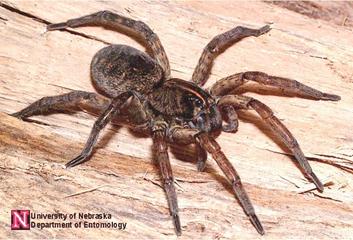 |
Wolf Spider |
Any large, hairy spider in the eastern half of the United States is more than likely a wolf spider. These spiders may grow to have bodies 1 inch long with a leg span of 2 or more inches. They are generally black or gray in color, but sometimes reddish, brown or tan. Two of their eight eyes are often larger than the rest.
Wolf spiders are active hunters that search for prey day or night. Some burrow and others rest in silken retreats beneath rocks, logs and vegetation. Females attach their egg sacs to their spinnerets and carry the egg sacs and spiderlings around after they hatch.
As with other large spiders, the bite of a wolf spider is likely to be felt but is not considered dangerous. Bites from these and other large spiders are not common.
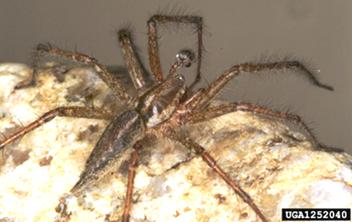 |
Funnel Web Spider |
Though they may occasionally wander into structures, funnel web spiders are typically found around the foundation of homes and in grasses and bushes. They remain hidden deep inside funnel-shaped webs that are quite noticeable on dewy mornings. Unlike many other web-building spiders, funnel web spiders are fast runners. When an insect or another spider happens by, the funnel web spider rushes out to subdue its prey.
The group includes medium-sized species such as the grass spiders (Agelenopsis spp.), usually found outdoors, and house spiders (Tegenaria spp.) which often occur indoors. Grass spiders are often brown with dark stripes on their backs.
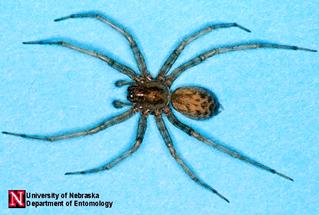 |
Common House Spider |
Their spinnerets are easily seen trailing from the tips of their long abdomens. The house spiders are brown with chevron-like markings on their abdomens.
None of the funnel web spiders inhabiting the United States should be considered dangerous. The bite of one species, the hobo spider (Tegenaria agrestis) has been implicated as a source of necrotic wounds. However, this has not been well-documented and it should be noted that the hobo spider is not considered dangerous in its native Europe. In the United States, the hobo spider inhabits only the Pacific Northwest from Utah to Washington. A very similar species, the common house spider (Tegenaria domestica) occurs throughout the United States and is easily mistaken for the hobo spider.
Some types of spiders are commonly found living and reproducing indoors. Included here are spiders that most of us have had frequent encounters with (cellar spiders and cobweb spiders), as well as some of medical importance (widow spiders and brown recluse spiders).
 |
Cellar Spider |
These spiders are sometimes called “daddy-longlegs” because of their long, delicate legs. Their tiny bodies are not more than ¼-inch long. Cellar spiders are most often seen hanging upside down in sheet-like or irregularly-shaped webs in corners near the ceiling or floor. The webs can quickly accumulate and become unsightly nuisances in cellars, basements or commercial buildings such as warehouses.
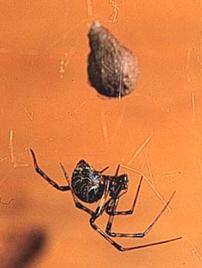 |
| Cobweb Spider |
The bulbous abdomen and much smaller head section of the cobweb spider gives it a characteristic spider shape. The group includes many medium-size species with bodies about ½-inch long that are black to brown in color with various patterns and markings.
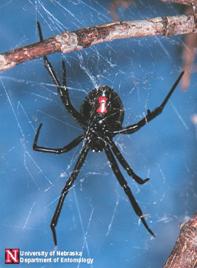 |
Black Widow Spider |
Cobweb spiders are also known as comb-footed spiders because of the comb-like bristles on the last segments of their hind legs which are used to wrap prey. These spiders hang in irregularly shaped webs that are usually positioned close to the floor in moist crawlspaces, basements and garages. If one web is unproductive, the spider will build another nearby, leaving the old web to gather dust and become a “cobweb.”
Widow spiders, such as the black widow (Latrodectus mactans), are cobweb spiders with bites that can be dangerous. But while the cobweb spiders typically found in homes may resemble widow spiders, their bites are not dangerous. Cick here for more information on black widow spiders.
These are small to medium-sized spiders that make “sacs” – tubular webs about 1-inch long, typically positioned between angled surfaces. The sacs are used as “retreats,” that is, the spiders rest in them by day and emerge at night to wander in search of prey. The retreats may be abandoned after only one day’s use, so household infestations of sac spiders are often easily identified, even without seeing the spiders, due to the prevalence of sacs around door and window frames, in corners, and where walls and ceilings meet.
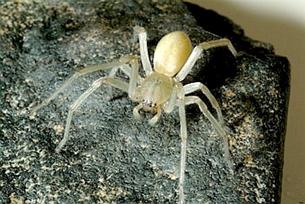 |
| Yellow Sac Spider |
Yellow sac spiders (Chiracanthium inclusum and C. mildei) are the most common species indoors. Their bodies are about ¼-inch long and, including legs, the spiders are less than the size of a quarter. They are a pale yellow color.
Yellow sac spiders are fast-running, nocturnal hunters that can be found from floor to ceiling in structures and will drop on a line of silk when disturbed. They also are common outdoors where they live in vegetation and often enter homes as temperatures drop in fall.
Because they are common indoors and may bite instinctively when touched, yellow sac spider bites may be more common than bites from any other spider in the United States. At least some of the injuries listed by medical personnel and poison control centers as “spider bites” or “brown recluse bites” are those of the yellow sac spider. Reactions to sac spider bites may vary. The bite is often felt as a sharp pain. Localized redness and swelling typically develop and dissipate within two hours.
There are several species of brown spiders in the United States. Most occur in the desert southwest. But the brown recluse (Loxosceles reclusa) inhabits the southeastern quarter of the United States, as far north as southern Illinois. Discoveries of brown recluse outside this range are rare.
The brown recluse is a small-bodied, medium-sized spider whose outstretched legs span little more than the diameter of a quarter. It is almost uniformly brown and without banded legs or other prominent markings – except for the dark violin-shaped mark on its cephalothorax, just behind its eyes. Unlike most spiders, the brown recluse has six eyes arranged in three pairs, instead of the usual eight.
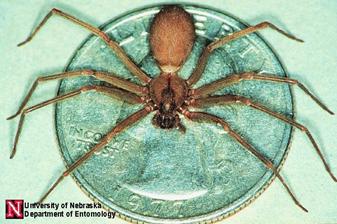 |
| Brown Recluse Spider |
Brown recluse are hunting spiders that wander at night in search of prey. Females make retreats in which they hide and ambush prey. A retreat consists of a mat of silk spun in a hidden location such as in a wall void or behind a picture frame. The brown recluse seems to prefer to rest on wood and paper surfaces.
Because brown recluse spend much of the day hiding inside furniture, boxes and stored goods, they are easily transported with these items. This and other characteristics allow them to establish themselves in new locations. They are long lived, can survive for many months without feeding, and females need mate only once to produce offspring throughout their lives. So it takes only one, mated female to start an infestation. Once established, they are difficult to control.
Yet even in heavily infested structures, brown recluse are indeed reclusive, not aggressive, and bites rarely occur. Nevertheless, physicians often misdiagnose many unrelated injuries as “brown recluse bites.” When they do occur, bites are rarely as serious as they have been portrayed. Some bites produce only localized redness and swelling. Severe necrosis probably occurs in less than 10 percent of cases, and may result more from bacterial infection of the wound rather than reaction to the spider’s venom. Click here for more information on brown recluse spiders.
As for most pests, effective spider control begins with identification. With spiders, identifying the species may not be necessary, but it is important to know whether the spider is a hunting spider or web-hanging spider.
Spiders that catch their prey in webs are usually found in or near their webs. These include cellar, cobweb, orb weaver and funnel web spiders. Often these spiders are more easily controlled than spiders that roam in search of prey. Control can be as simple as destroying the webs and squashing the spider with a fly swatter, newspaper or shoe. A vacuum cleaner works well too and leaves less mess. Vacuuming spiders and their webs is a good, non-toxic method that also can be used on hunting spiders, if you are quick enough.
A structure’s exterior is a good place to start to prevent spiders from entering.
Funnel web and sac spiders, for example, are prone to enter structures in the fall. To help prevent this, check the foundation for cracks and holes. Also check vents, around window and door frames, and for gaps around utility and cable lines. Seal these potential entry points with caulk, expandable foam, concrete or similar materials.
Try to keep doors and windows screened and shut. Install door sweeps to keep spiders from entering beneath doors. Minimize lighting that is visible from outside because lights attract insects, and insects attract spiders. If you must have outdoor lighting, use yellow “bug lights” or sodium vapor lights instead of white lights and mercury vapor lights.
Vegetation and mulch around the structure’s foundation should be kept to a minimum where possible. Maintaining a rock or gravel border about 2-feet wide around the foundation is best because vegetation and mulch attract insects and give spiders a place to build webs. Moisture accumulating around foundations and in basements and crawlspaces creates a favorable environment for insects and spiders. Moisture control measures include, sealing cracks, fixing water leaks, correcting grades, and ventilation and polyethylene sheeting in crawlspaces.
Still, some spiders may enter structures even though extensive work has been done to exclude them. Crab spiders and sac spiders may “hitchhike” indoors on flowers and plants. And brown recluse spiders enter structures, hidden in furniture, boxes and other goods. These items should be thoroughly inspected and cleared of spiders before they are brought in.
Sticky traps are another non-toxic means of insect and spider control. These traps are nothing more than adhesive on cardboard. Most sticky traps, also known as monitors, are about the size of a small letter envelope. Some can be folded into a box or triangular configuration that helps protect the adhesive from dust and debris.
Sticky traps can be purchased at lawn-and-garden centers, discount and hardware stores, from pest control product retailers and distributors, and on the Internet. They can be effective against hunting spiders including funnel web, wolf, nursery web, woodlouse and brown recluse spiders. Traps should be placed indoors wherever these spiders travel, e.g., along walls, behind furniture, and around potential entry points such as garage doors. For species that typically run across flooring, such as brown recluse spiders, the use of sticky traps – and lots of them – is important, not only to trap the spiders, but to help pinpoint infested parts of the structure that can be sealed and/or treated with pesticides if necessary.
Pesticides can be effective against spiders, but in many cases control is not achieved by the use of pesticides alone. As with many pests, the greatest degree of control results from the combined use of several control methods, that is, integrated pest management.
The application of pesticides around a structure’s foundation, known as a barrier or perimeter treatment, can be effective, for example, when applied in early fall to help prevent sac spiders from entering. However, perimeter application may not be necessary if vegetation, mulch, leaf litter, etc., are kept away from the foundation as mentioned above.
Indoor pesticide use is best applied to cracks, crevices and voids that harbor spiders. Dust formulations can be used in wall voids, voids around fireplaces, and in crawlspaces and attics, but should not be applied to easily accessible areas or false ceilings. Microencapsulates or wettable powder formulations can be effectively applied to attics, crawlspaces and basements as well as the structure’s exterior.
Again, proper identification of the spiders and their habits will determine which control methods are best to use and, in the end, how effective those methods will be. For some, hiring a pest management professional may be best.
Photos and illustrations courtesy of University of Nebraska, United States Fish and Wildlife Service, Peter J. DeVries – Spiders of Wisconsin: http://spiders.entomology.wisc.edu/, Richard Bradley, and Stephanie Newhouse.
NOTE: When pesticides are used, it is the applicator’s legal responsibility to read and follow directions on the product label. Not following label directions, even if they conflict with information provided herein, is a violation of federal law.
For more information, contact the Illinois Department of Public Health, Division of Environmental Health, 525 W. Jefferson St., Springfield, IL 62761, 217-782-5830, TTY (hearing impaired use only) 800-547-0466.
| Illinois Department
of Public Health 535 West Jefferson Street Springfield, Illinois 62761 Phone 217-782-4977 Fax 217-782-3987 TTY 800-547-0466 Questions or Comments |